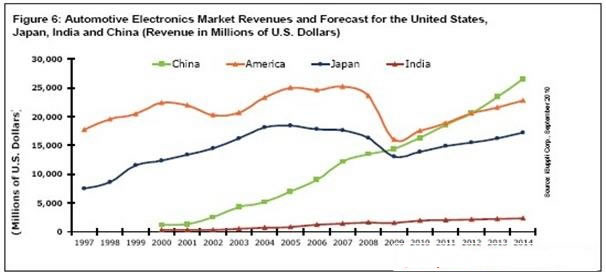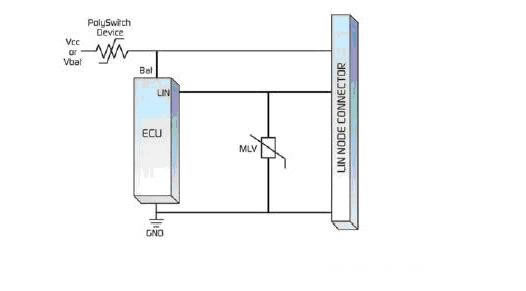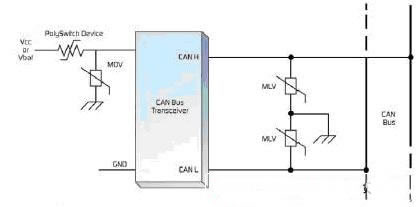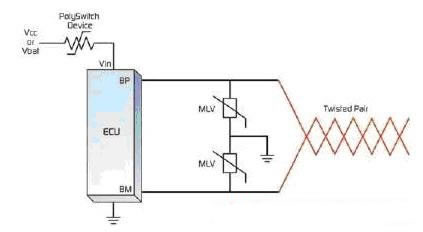In the future of automotive electronic systems, as the demand for safety, energy saving, environmental protection, comfort and entertainment increases, the shipment of related components and their peripheral products will continue to grow rapidly. Many design challenges in the field of automotive electronics require consideration of solutions from the component level. Around this topic, introduce the application of new sensors, protection devices, high-voltage connectors in automotive power control, security systems, communication entertainment, charging and discharging systems.
This article refers to the address: http://
The speed of technology upgrades for automotive electronics is quite fast compared to other application areas such as industrial control and medical care. There are many reasons for this. First of all, automotive electronics is closely related to people's daily lives. Especially in Europe and the United States, cars are a necessity, and it is almost the only choice for most people to travel daily. In the emerging emerging markets such as China and India, the automobile market is growing rapidly. According to the latest report, the number of cars in Shenzhen has just exceeded 1.7 million, making it the most densely populated mainland city. It can be seen that more and more families have the demand for car purchase, which promotes the wide application and development of automotive electronic technology.
According to isuppli's survey, China's auto electronics sales will increase from $16 billion in 2009 to $20.6 billion in 2012. In 2012, the US automotive electronics market will be $20.5 billion, and the first position will be given to China.

Cars have multiple subsystems that are very complex. Each subsystem is inseparable from a large number of automotive electronics - of course, the number of cars used in different levels of cars is not the same. For example, the current mainstream automotive electronic systems in the Chinese market are not too complicated and the level of intelligence is not high. These systems focus on steering, driver assistance, occupant passive protection, braking and control systems, and comfort.
As the market upgrades, the future of automotive electronics applications will also face changes, energy systems, security systems, collision avoidance, wire-controlled driving, control systems, smart sensors and actuators, integrated automotive electrical and electronic systems and thermal comfort systems. Will play a more important role.
Below, we will analyze the opportunities and challenges that these emerging needs bring to the component market.
The role of components in automotive safety systems
Safety is the first element to consider in the design of automotive systems. The new driving safety is inseparable from the stable engine management system, and the sensor device is one of the most used devices in the car, and is also widely used in the safety system.
In terms of driving safety, timely detection of engine temperature is a very important part. At the same time as testing, reliability and service life must also be ensured. TDK's latest sensor weighs only 50% of the traditional metal structure, but while ensuring temperature detection accuracy, shock resistance and service life have also been greatly improved. The plastic housing on the top of the sensor ensures excellent thermal conductivity, which optimizes reaction time and accuracy, and is useful for measuring automotive oil temperature and coolant temperature. In addition, the quick response and wide adaptability are also the characteristics of this product.
In normal operation such as starting and stopping, the car will be affected by electrical interference and high frequency, causing interference. Conducted through the wiring system, eventually coupled or radiated to the in-vehicle electronic device. Sources of interference include start-up systems, AC motors, load switching, switching jitter, and “load dumping†(ie, the power that is turned off during DC motor operation, resulting in voltage).
The most devastating of these surges is the “load throwing†that occurs while the engine is running, disconnecting the battery while the AC motor is charging the battery. The magnitude of the transient voltage generated depends on the speed of the AC motor and the amount of field excitation when disconnected. This surge can last for hundreds of milliseconds, producing voltages above 100V, with potentially fatal effects on semiconductor circuits. Once the electronic circuit is damaged, it may pose a great safety hazard.
The PPTC protection device is a resettable polymer positive temperature coefficient device that has been used for overload and short circuit protection of the DC output of the power supply. Tyco Electronics' RaySwitch products provide protection for power supplies, RXE input/output interfaces, and protection against overheating and motor stalls.
In addition to PPTC devices, MOSFETs provide similar protection. However, in addition to its high frequency performance, high input impedance, low drive power, and excellent thermal stability, MOSFETs enable power components to meet the lowest system cost, resulting in a superior fault self-protection system. Therefore, most designers turn to a MOSFET power component with protection.
Application of semiconductor components in automotive entertainment systems
Infotainment devices are also susceptible to damage due to excessive transient voltages, including the working environment in which they are located and the electrostatic discharge (ESD) pulses generated by peripheral devices. ESD protection devices, metal oxide varistor (MOV) and Zener diodes are often used to protect automotive electronic devices such as antennas, backlight heaters, batteries, buttons, printed circuits on circuit boards, CD/DVD players, data lines Ports, hard drives, and input/output ports and touch screens.
Portable devices that are charged in the car have a great need for overcurrent and overvoltage protection, and Tyco Electronics' PolyZen devices can meet the protection needs. When used with a Zener diode-like protection device, this device has a synergistic protection against high power fault conditions.
The high-speed I/O ports in the car require ESD protection devices with small capacitance to keep the signal quality as low as possible. The device chosen should be suitable for high-speed data transmission lines and radio frequency data lines, capable of withstanding numerous ESD transients.
PPTC circuit protection devices are widely used in car infotainment systems. It acts as a practical, cost-effective solution that protects against overcurrent and overheating. It is also often used to limit current in GPS, DVD or radio and telematics boards.
New energy vehicles lead the trend of high voltage connectors
The rapidly growing market for electric vehicles and hybrid electric vehicles will trigger a large number of high-voltage connector applications that are new and eye-catching. Different car manufacturers are experimenting with different approaches to achieve low or zero displacement targets, which will further increase the requirements for connector suppliers. There is a commonality between these requirements, which is to reduce costs and reduce weight and volume while meeting different levels of safety and personal protection requirements. At the same time, manufacturers will not give up the high reliability and durability that modern consumers expect.
Among connector manufacturers, FCI has strong competitiveness in the electric vehicle and hybrid vehicle markets. The new Power.S3 series is designed for plug-in hybrid and electric vehicles driven by a new generation of rechargeable batteries.
The use of high-capacity lithium batteries is a common feature of the diverse choices of electric and hybrid vehicle designs. The working voltage of the lithium battery ranges from 400 to 600V. This is at least 10 times more than the traditional automotive standard 14V lead-acid battery, so FCI Connector has developed a comprehensive solution that uses specialized connectors and charging plugs.
These new connectors and charging plugs need to solve many major problems. Among them, the most important is the safety problem, because the new connector and charging plug work range of 400~600V, the working current range is 50~300A or even higher. The high standard of protection against electric shock is obvious given that the operator will inevitably come into contact with the engine compartment throughout the life of the vehicle. In addition, at such high power, electromagnetic interference is another important issue. Also, arcing occurs during connector insertion and removal operations, which can seriously jeopardize electrical connections and electronic equipment and can cause the car to burn.
With the advent of large-capacity lithium batteries, dangerous failure modes have been triggered in some cases. In addition, how to reduce the weight and cost of the battery is still a problem: on the one hand, increasing the cruising range of the electric vehicle and the capacity of the battery means that the weight of each component is reduced; on the other hand, because the new generation of electric vehicles is firmly fixed Positioning in the mass market, economics also plays an extremely important role. And the cost of the battery alone can be as high as several thousand euros, so the pressure to reduce the cost of other configurations in the car is even greater.
To meet all of these challenges, FCI Connector's Power.S3 series of new connectors and charging plugs are optimized for high power operation, cost competitiveness, durability, compactness, ergonomics and personnel safety. the design of. FCI Connector and REMA (REMA is a professional manufacturer of plugs and sockets for electric forklifts), the first cooperation result is single-phase 16/32A charging plug and socket, in line with SAE J1772 and IEC62192-1 Standard: International standard for "slow charge" electric vehicle / hybrid vehicle applications. These products are used to charge the car's lithium battery at a public charging station or at home, charging time is 4~8h.
The automotive sector is still pioneering, and it is not easy for engineers to ensure that the system works flawlessly. This performance-oriented simulation and analysis is critical for designers of electric and hybrid vehicles. Companies involved in the design and manufacture of these new vehicles are in a rapidly evolving learning phase, and there is much to be learned about the performance of the product in real-world applications.
Vehicle network system circuit protection scheme
In-vehicle network systems will play an increasingly important role. New passenger cars, trucks, buses and even motorcycles have become mobile networks that connect features and functions such as built-in controls, mobile media and wireless networks. Applications such as infotainment systems, telematics, security controls, etc. require several existing network standards, of which LIN, CAN, and FlexRay are the three most important standards.
Circuit protection measures for LIN topology
The LIN bus topology is typically used to connect switches, sensors and actuators to the on-board network. LIN bus standards require that the network should resume normal operation when the LIN main line is shorted due to a positive voltage less than 26.5V or ground. The ESD surge resistance on the physical layer must meet the minimum discharge voltage level of ±2kV according to IEC61000-4-2. However, a level of ±8kV may appear on the ECU connector.
The following figure shows a coordinated circuit protection diagram showing how a resettable PolySwitch device placed at the power input protects the ECU and LIN node connectors from overcurrent conditions at the power input and an MLV (multilayer voltage sensitive) Resistors) How to provide the required overcurrent protection for high current handling and energy absorption for in-vehicle networking applications.
Overcurrent protection is required to limit the overcurrent when a fault or overload occurs. It is also necessary to limit voltage spikes or to maintain a stable overvoltage condition through circuit protection devices.

Circuit protection measures for CAN topology
The CAN bus transceiver allows bus supply voltages up to +/-80V DC. However, load dump surges can produce higher transients than specified in the ISO-7637-2 standard (maximum 86.5V) and can damage the transceiver. The operating current of the transceiver also varies from vendor to vendor.
The figure below shows how to apply a resettable PolySwitch device and MOV (Metal Oxidation Voltage Resistor) to the power input to avoid damage due to surge current and voltage anomalies in the center of the vehicle's power supply system.

Circuit protection measures for FlexRay topology
The FlexRay protocol is designed for wire-controlled applications such as wire-controlled brakes and wire-controlled steering wheels. The wire-controlled network mode supports synchronous and asynchronous data transmission with a data transmission rate of approximately 10 Mb/s, featuring time-triggered and event-triggered behavior, redundancy and fault tolerance.
The architecture supports a "bundle" of 2 nodes to 64 nodes, the function of which relies on two types of processors - ECU and "active star". FlexRay communication takes place between ECUs via a common bus or a star connection. The bus input of the FlexRay component must avoid short circuits between the main line and the system supply voltage or ground potential.
The following diagram uses a PolySwitch device for overcurrent protection.

Car lighting circuit protection scheme
On-board lighting systems require peak surge currents of up to 55A. One of the ideal solutions for controlling automotive lighting is to combine a high side pre-FET driver with a power FET.
A pre-FET driver is used to control the four different loads in the system. This combination enables better control of the resistive load by the temperature coefficient. Typically, the load is connected to the low side and the power FET is configured on the high side to power the load. Each channel can be controlled by a parallel input signal from the microcontroller or a serial programming register. In a parallel architecture, a general purpose I/O or timer based output is used to control the load current.
The gate drive output is typically a constant current source and sinks the output to control the FET gate capacitance charge and discharge characteristics. An external resistor in series with the output limits the number of FET switch transitions. This effect allows the slew rate to be controlled while also helping to reduce the rapid current changes that occur during switching limits that increase electromagnetic interference (increasing switching losses and power dissipation). These outputs are internally controlled below the maximum output voltage of 17V to protect the external FET gate from source breakdown damage. The combination of the pre-FET driver and power FET can be configured to prevent dynamic and static faults in the application compared to an integrated solution.
Vehicle lighting circuit fault detection and control scheme
Fault detection is critical in all systems. The ability to independently detect faults in the "on" state for short-circuit loads and overcurrents, as well as for each channel with an open load in the "off" state, will enable the system to react correctly. This type of detection also isolates faulty channels to avoid affecting other normal channels, especially when it comes to thermal interaction problems.
When an overcurrent condition is detected, the FET can be protected by "turning off" the device or activating an option setting that will automatically retry and "turn on" the FET with a low duty cycle. This allows the system to constantly check to see if the fault has been eliminated and will not destroy the FET.
Monitoring open circuit load faults in the "off" state provides load integrity information to the system. By monitoring the supply voltage of the external power FET when the switch is fully "off", the detection of an open circuit load fault for each channel can be achieved.
Similarly, to prevent erroneous fault reporting during switching, an anti-spike filter is activated during power conversion to mask the fault. The anti-spike masking time can be programmed to compensate for all slew rate control implementations. If the open load occurs after switching, the fault is determined to be valid longer than the fault mask before the system makes the correct action. The correct action is to keep the FET in the "off" state.
Combining a high-side-side pre-FET driver with a power FET is widely used for load control, such as automotive electronics, incandescent bulbs, relay solenoids, and transmission solenoids, and may also be used for those that require serial communication. Communication or parallel input control for industrial and commercial applications that implement load control. The ability to isolate each power FET from thermal interaction is very beneficial in situations where single-channel shorts or thermal shutdown faults do not interrupt other load control channel functions.
Semiconductor device solutions in hybrid vehicles (HEV)
The challenge of high voltage is the problem that hybrid vehicles must solve. A few years ago, most of the power devices in automobiles were 55V to 60V MOSFETs, mainly used in automotive powertrains. Today's cars, including hybrid cars, use 20V to 600V power devices. For applications such as power steering and braking, development engineers are looking for high-performance low-voltage trench MOSFETs with low on-resistance to reduce vehicle power consumption.
The light, full-featured and plug-in HEVs require high-voltage electronic systems between 600V and 1,200V, making the design more challenging. In addition to the high voltage capability of up to 600V to 1,200V, there is also a need to drive switches of unprecedented current density in inverters and DC/DC converters. To face such high power, high voltage and high energy, power ICs must be based on ruggedness, reliability and safety. Dr. Hauenstein of IR has stated that the protection function of the motor drive IC is very important, eliminating the need for interaction of the microcontroller in the event of severe faults and short circuits in the HEV traction motor. Because this problem is very common in HEV inverters when switching high current, high voltage IGBTs. â€
IR's HEV solution portfolio also includes drivers and switches with very low EMI and optimized switching performance. For example, the latest DirectFET MOSFET products use no bond wires at all, and provide the best switching performance because they eliminate most of the parasitic inductance and have the smallest package resistance. In addition to leading industry low on-resistance, excellent switching performance and enhanced temperature efficiency (eg double-sided heat dissipation), this state-of-the-art bond-free chip-size package allows for a significant reduction in design, especially for high Power requirements or fast switching applications such as HEVDC/DC converters.
As the core technology of hybrid vehicles, IGBTs and power MOSFETs attract power semiconductor manufacturers to target this huge market. ISuppli has predicted that the automotive IGBT market is expected to grow at a rapid rate of 17.2% per year, ranking first among automotive power management devices, with the MOSFET market growing second. While hybrid vehicles will only occupy a small portion of the vehicle market in the next few years, the combined demand for hybrids and DC/DC by hybrids will create a huge market demand for IGBTs and power MOSFETs.
China's major automotive electronics market and development opportunities
Safety, energy saving, environmental protection, and intelligence and informationization are the development trends of the future car. The Chinese automotive market has enabled the rapid development of automotive entertainment systems, an increase in exponential growth at existing market scales. Market research shows that China's overall car production is very large, and the number of in-car entertainment systems is also considerable, mainly providing OEM support services.
The car uses the computer as a platform to achieve functions such as in-vehicle communication, navigation, audio-visual entertainment, network control, integrated multimedia information system designed for the integration of regional market trends. Some surveys have shown that China's current market development prospects exist in the large automotive electronics market. The driving safety of cars and the control of entertainment navigation information systems related to small cars, body-related electronic control, etc., will become the main direction of the development of China's automotive electronics market.
China 3 Light Pendant,Multi Light Pendant manufacturers, welcome Linear Pendant Lighting,Multi Lights Pendant Light purchasers from worldwide to visit our site.
the types of lamps include pendant lamps, table & floor lamps, chandelier, Wall Lamp ,desk lamp and etc., the materials include steel, metal, fabric, crystal, glass, aryclic and so on.
We offer samples with new designs every month to update our showroom and well display in lighting exihibtions.
We can make samples for his own designs as per shop drawings even potential idea from customers.
Multi Lights Pendant Light
3 Light Pendant,Multi Light Pendant,Linear Pendant Lighting,Multi Lights Pendant Light
Monike lighting , https://www.monikelight.com
